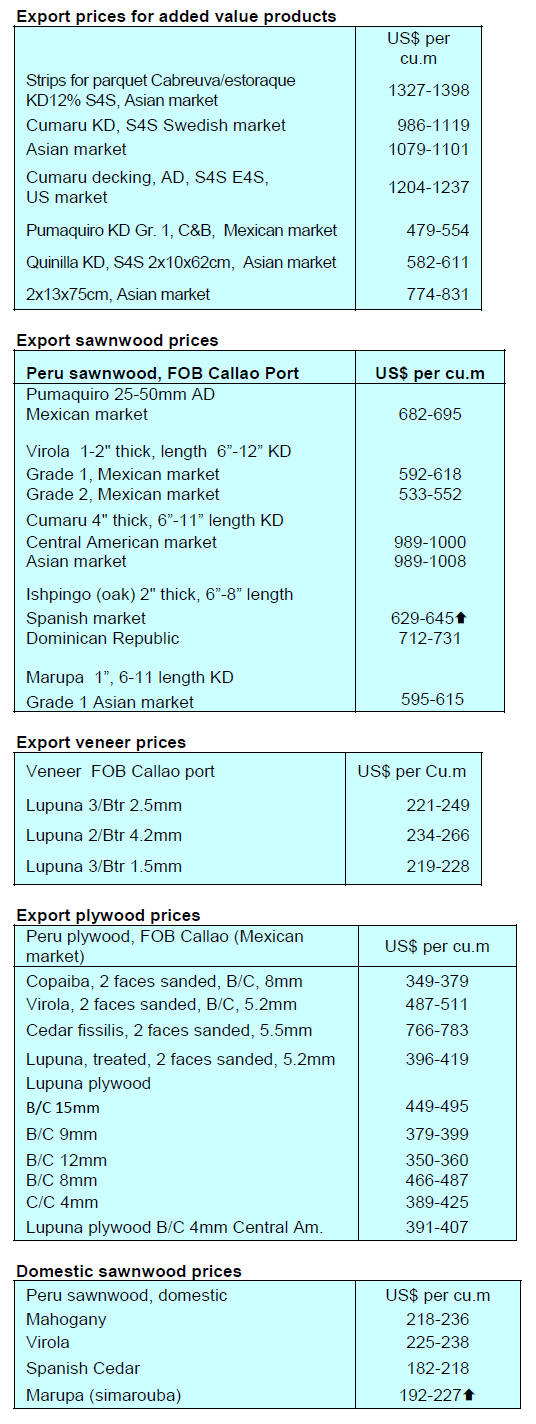4.
INDONESIA
Indonesia ready to challenge EUDR
The Director General of Sustainable Forest Management,
Ministry of Environment and Forestry (KLHK), Agus
Justianto, is reported as saying Indonesia is ready to
challenge the European Union (EU) at the World Trade
Organisation (WTO) regarding the enactment of the
deforestation-free law which, Indonesia considers, will
become a trade barrier for wood products. The media
reports Indonesia considers this regulation unilaterally
violates the agreement on the export of wood products
between Indonesia and the EU which was signed in 2013.
Under the new EU regulation Indonesia's main export
products will be subject to a due diligence process if they
enter the EU market. The commodities are wood, soybean,
palm oil, cocoa, coffee, rubber and beef and their
derivative products such as cowhide, chocolate and
furniture.
Agus commented that it is surprising that wood products
are included as Indonesia and the EU already have a
Voluntary Partnership Agreement (VPA) on forest law
enforcement, governance and trade (FLEGT) which was
signed on 30 September 2013 and became effective on 1
May 2014.
The Indonesian Ambassador to Germany, Arif Havas
Oegroseno, is quoted as saying Indonesia has two options
to resolve this case with a third party, the WTO or the
European Court of Justice.
See:
https://agroindonesia.co.id/terkait-regulasi-bebasdeforestasi-indonesia-siap-gugat-uni-eropa-ke-wto/
Minister approves allowing furniture makers to cut
wages
The Minister of Manpower, Ida Fauziyah, issued a
regulation allowing wooden furniture companies to cut
wages by up to 25%. This provision is contained in the
Regulation of the Minister of Manpower No. 5 of 2023
concerning Adjustment of Working Time and Wages in
Certain Export-Oriented Labour-Intensive Industrial
Companies Affected by Changes in the Global Economy.
This regulation was promulgated and took effect on 8
March 2023. The wooden furniture industry is one of the 5
categories of labour intensive and export-oriented
industries regulated in this provision. Besides furniture,
other industries are the textile and apparel industry, the
footwear industry, the leather and leather goods industry
and the children's toy industry.
Industries that are allowed to cut wages according to this
provision must meet at least 3 criteria as stipulated in
article 3 paragraph 1 of the Minister of Manpower
Regulation. First, the industry has a minimum of 200
workers or labourers. Second, the percentage of labour
costs in production is at least 15%. Third, production
depends on orders from the United States and countries in
the EU.
Emelia Yanti Siahaan, Coordinator for Sectoral Social
Dialogue (DSS) said in a press conference that Regulation
No. 5 of 2023 has legalised labour welfare degradation.
Emelia said that the wage cuts will affect more than 5
million labourers. Emelia added that wage cuts have been
occurring since last year. In 2022 Statistics Indonesia
recorded that around 51% of labourers in the five industry
sectors to be affected have been receiving wages below the
City Minimum Wage.
See:
https://forestinsights.id/2023/03/17/menaker-terbitkanperaturan-perusahaan-furnitur-kayu-boleh-pangkas-upah-buruhsampai-25-persen-download-di-sini/
and
https://en.tempo.co/read/1705101/labourers-protest-overregulated-wage-cuts
Furniture exports almost US$3 billion
Indonesia’s furniture and crafts exports reached US$2.8
billion in 2022 and the government hopes that exports will
increase to US$5 billion in 2024.
To help achieve this the Minister of Industry, Agus
Gumiwang Kartasasmita, highlighted the ministry’s
support policies including ensuring a supply of raw and
auxiliary materials, increasing technological capability and
human resource capacity, tax incentives, design
development and facilitating participation in exhibitions.
He added that the furniture industry should take advantage
of the expanding domestic market which would help
reduce the dependency on imported products which
reached US$496 million in 2022.
The Ministry of Industry has two strategies to improve
profitability in the sector. First, greater emphasis on the
domestic market as the size of this market, especially the
middle class segment, continues to expand. The second is
exports to non-traditional markets for example India and
the Middle East where growth in the property sector is
relatively stable.
In related news, Reni Yanita, the Director General of
Small, Medium and Multi-various Industries of the
Ministry of Industry urged small and medium furniture
and craft industry players continue to follow global market
trends and actively innovate products. According to Reni
Indonesia has an advantage because of the variety wood,
rattan and bamboo raw materials to produce unique and
attractive designs. The Indonesian Furniture and Craft
Association (HIMKI) chairman, Abdul Sobur, revealed
that exports to the EU declined in 2022 so HIMKI
members are now investigating the Middle East markets
such as Qatar, Israel and the United Arab Emirates.
See:
https://www.msn.com/id-id/berita/other/kemenperinmencatat-nilai-ekspor-industri-furnitur-mencapai-us-28-miliar/ar-AA18w6hF
and
https://www.antaranews.com/berita/3438735/kemenperinoptimis-indonesia-trendsetter-furnitur-ramah-lingkungan
Indonesian furniture products attract business at
Vietnam Fair
The Ministry of Trade noted that Indonesian furniture and
home decor products had managed to attract potential
transactions worth over US$850,000 at the Vietnam
International Furniture and Home Accessories Fair (VIFAExpo).
Director General of National Export Development of the
Ministry of Trade, Didi Sumedi, said that Indonesia's
participation in the 2023 VIFA-Expo was an effort to
attract more buyers of Indonesian furniture and home
decor products from many countries.
See:
https://validnews.id/ekonomi/industri-furnitur-indonesiacatatkan-transaksi-rp131-m-di-vietnam
Ministry identifies five new sources of economic
growth
At an international seminar on credit assessment
Indonesian Deputy Minister of Finance, Suahasil Nazara,
outlined five new sources of long-term economic growth
that could support people's welfare.
The first is the down-streaming of natural resources with
high added value. The next is the use of local products
and the third is acceleration of the digital economy. In
addition, the green economy and energy transition as well
as the strengthening of micro, small and medium
enterprises (MSMEs) could also serve as new sources of
economic growth.
See:
https://en.antaranews.com/news/275832/ministry-identifiesfive-new-sources-of-economic-growth

Through the eyes of industry
The latest GTI report lists the challenges identified by the
private sectors in Indonesia.
See:
https://www.ittoggsc.org/static/upload/file/20230214/1676340295137619.pdf
5.
MYANMAR
Shipments to EU and USA sharply down
According to exporters, timber shipments to EU and USA
fell sharply during the past six months as importers and
distributors are reluctant to trade Myanmar timber.
Previously timber legality issues were prominent, but now
the political situation is to the forefront.
New Protected Forest Areas
The Ministry of Natural Resources and Environmental
Conservation has designated two areas in Shan State
and Sagaing Region as Protected Public Forest under the
Forest law 2018. In Myanmar the Permanent Forest Estate
(PTE) is constituted of Reserved Forest and Protected
Public Forest (PPF). Reserved Forest is set aside in areas
suitable for commercial timber where the public has no
harvesting right. On the other hand, PPF is mainly
designed for conservation.
Economic growth forecast to rise
The State-Owned Newspaper quoted Myanmar Prime
Minister Major General Min Aung Hlaing as saying that
the country's economic growth increased by 3.4% in fiscal
2022-2023 and officials have predicted that there will be
continued growth. The Prime Minister also declared that
the monetary circulation in the country was brought back
normal in mid-2022.
In related news, the S&P Global Myanmar Manufacturing
PMI Index report released for January 2023 states that not
only the production of Myanmar manufacturing
companies but also the new businesses have reverted to
growth.
See:
https://www.gnlm.com.mm/only-when-the-economicdriving-force-improves-will-it-support-political-and-defencedriving-forces-senior-general/#article-title
and
https://www.pmi.spglobal.com/Public/Home/PressRelease/e110867c2dac415081675ac75c8b9dec
EU imposes sixth round of sanctions
A February 2023 press release from the Council of the EU
called for an end to all hostilitiesin Myanmar adding that
the military authorities must fully respect international
humanitarian law and put an end to the indiscriminate use
of force.
The press release reaffirms the European Union support
for ASEAN’s and the UN´s efforts to help Myanmar to
find a peaceful solution to the crisis and welcomes the UN
Security Council’s adoption of Resolution 2669 on
Myanmar.
The press release says Myanmar should swiftly and
faithfully implement ASEAN’s Five-Point Consensus, as
reiterated at the 40th and 41st ASEAN Summits in
November 2022 and at the EU-ASEAN Commemorative
Summit in December 2022.
The same press release announced further sanctions
against 9 individuals and 7 entities in view of the
continuing escalation of violence, grave human rights
violations and threats to the peace, security and stability in
Myanmar.
See:
https://www.consilium.europa.eu/en/press/pressreleases/2023/02/20/myanmar-burma-eu-imposes-sixth-round-ofsanctions-against-9-individuals-and-7-entities/?utm_source=dsmsauto&utm_medium=email&utm_campaign=Myanmar%2fBurma%3a+EU+imposes+sixth+round+of+sanctions+against+9+individuals+and+7+entities
6.
INDIA
Low oil prices pull down inflation
rate
The annual rate of inflation based on the India Wholesale
Price Index (WPI) in February was 3.85% compared to
4.73% recorded in January 2023. The decline in the rate of
inflation in February was primarily because of a fall in
prices of crude petroleum and natural gas.
Out of the 22 NIC two-digit groups for manufactured
products, 13 saw increases in prices while 9 saw a decline.
The increase in prices are mainly contributed by basic
metals; fabricated metal products, machinery and
equipment; other non-metallic mineral products;
pharmaceuticals and medicines. Some wood products were
in the group where the price indices declined.
See:
https://eaindustry.nic.in/pdf_files/cmonthly.pdf

Plan to cut imports of non-essential goods
The government plans to cut imports of non-essential
goods in order to encourage greater domestic production.
The Commerce Secretary, Sunil Barthwal, said that his
ministry will coordinate with other ministries.
Containing non-essential imports would also help reduce
the trade deficit which has reached US$247 billion
between April 2022 and February 2023 as against US$172
billion in the same period in the last fiscal year. Imports
during the 11-month period of the current fiscal increased
19%.
See::
https://economictimes.indiatimes.com/news/economy/foreigntrade/government-undertaking-an-exercise-to-cut-imports-ofnon-essentialitems/articleshow/98672933.cms?utm_source=contentofinterest&utm_medium=text&utm_campaign=cppst
Mid-income Housing Investment Fund report
The special support from the Affordable and Mid-Income
Housing Ivestment Fund (SWAMIH) has completed
20,577 homes since its inception in 2019 and hopes to see
completion of 81,000 homes over the next 3 years in 90
Tier 1 and 2 cities. SWAMIH has provided approval for
about 130 projects worth over Rs.12,000 crore. The fund
is sponsored by the Ministry of Finance and is managed by
SBICAP Ventures Ltd. a State Bank.
Since the Fund considers first time developers, established
developers with troubled projects, stalled projects or even
projects with litigation issues it is considered as the lender
of last resort for distressed projects.
See:
https://timesofindia.indiatimes.com/india/affordablehousing-fund-aims-to-ready-81ooo-houses-in-3-years/articleshow/98421638.cms?from=mdr
State of Forest report 2021 released
The Minister for Environment, Forest and Climate
Change, Shri Bhupender Yadav, introduced the ‘India
State of Forest Report 2021’ prepared by the Forest
Survey of India (FSI) which has been mandated to assess
the forest and tree resources of the country.
See:
https://pib.gov.in/PressReleasePage.aspx?PRID=1789635
The main findings include:
An increase of 2,261 sq km in the total forest and
tree cover of the country in last two years.
Madhya Pradesh has the largest forest cover in
the country.
The maximum increase in forest cover witnessed
in Andhra Pradesh (647 sq km) followed by
Telangana (632 sq km) and Odisha (537 sq km).
17 states/UT’s have above 33 percent of the
geographical area under forest cover.
The total carbon stock in country’s forest is
estimated to be 7,204 million tonnes, an increase
of 79.4 million.
The total mangrove cover in the country is 4,992
sq km, an increase of 17 sq Km observed.
In related news, according to a recent report, India
has
experienced the highest rise in deforestation in the last 30
years with a surge recorded between 2015 and 2020.
In this period the country was ranked second only after
Brazil, with average deforestation of 668,400 hectares
(ha). The report, released in March this year analyses
deforestation trends in 98 countries over past 30 years.
While India lost 384,000 ha of forests between 1990 and
2000 the figure rose to 668,400 ha between 2015 and
2020.
See:
https://www.downtoearth.org.in/news/wildlifebiodiversity/india-lost-668-400-ha-forests-in-5-years-2ndhighest-globally-report-88337
and
https://www.utilitybidder.co.uk/compare-businessenergy/deforestation-report/
114-year-old teak tree autioned for almost US$50,000
A 114-year-old teak tree planted during the colonial-era
has been auctioned for four million rupees (US$49,000),
in Kerala. The Nedumkayam Forest Depot auctioned the
tree, planted in 1909, after it fell in the Nilambur teak
plantation. Teak trees at the park are harvested only after
they fall naturally.
See:
https://www.thenationalnews.com/world/2023/02/22/indiaskerala-forest-department-auctions-teak-tree-planted-by-thebritish-for-49000/
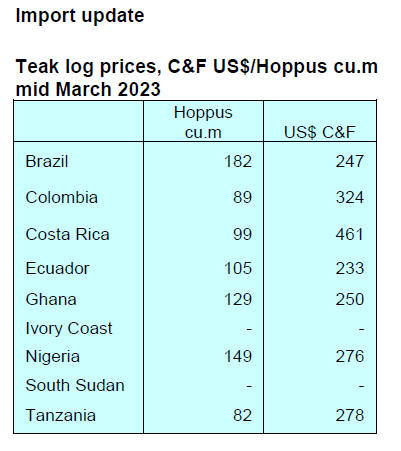
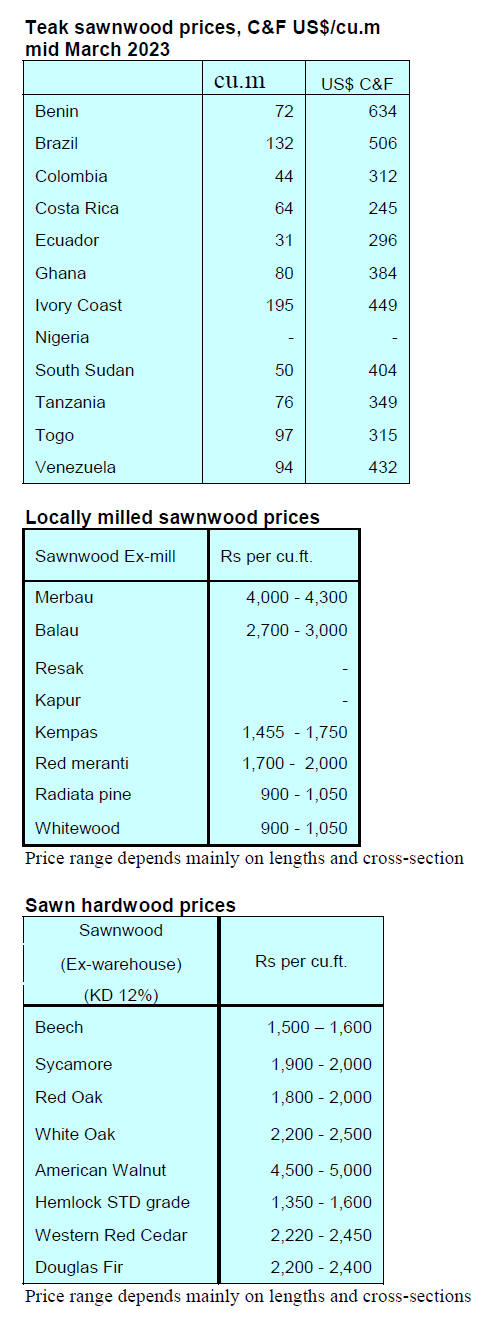
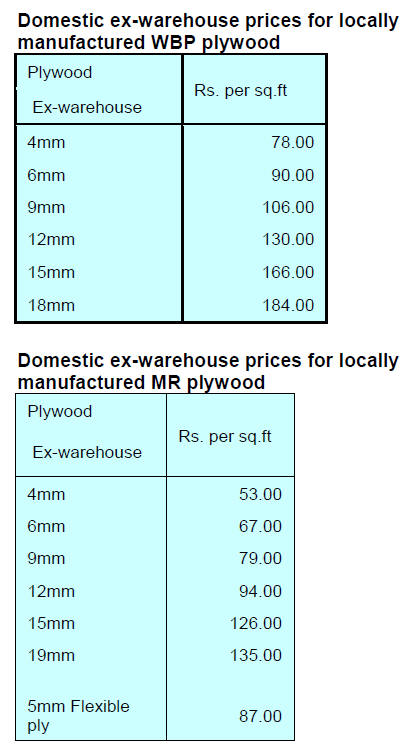
7.
VIETNAM
Vietnam – Wood and Wood Products (W&WP)
Trade
Highlights
According to the Vietnam General Department of
Customs, W&WP exports in February 2023 were valued at
US$880.2 million, down 2% compared to February 2022.
WP exports contributed US$556.7 million, down 20%
compared to February 2022.
In the first 2 months of 2023, W&WP exports stood at
US$1.7 billion, down 32% over the same period in 2022 in
which WP exports shared US$1.05 billion, year-on-year
down 44%.
The W&WP exports to Japan in February 2023 reached
US$142.3 million, up 50% compared to February 2022. In
the first 2 months of 2023 W&WP exports to the Japanese
market reached US$270.2 million, up 11% over the same
period in 2022.
Vietnam's office furniture exports in February 2023 earned
US$20.3 million, down 0.7% compared to February 2022.
In the first 2 months of 2023 office furniture exports
generated US$39.3 million, down 29% over the same
period in 2022.
W&WP imports in February 2023 amounted to US$150.4
million, up 25% compared to January 2023 but compared
to February 2022 imports decreased by 21%.
In the first 2 months of 2023 W&WP imports were valued
at US$270.5 million, year-on-year down 39%.
Vietnam's imports of tali in February 2023 have been
reported at 45,000 cu.m, worth US$18.2 million, up 15%
in volume and 15% in value compared to the previous
month, but year-on-year imports dropped by 7% in volume
and 4% in value.
In the first 2 months of 2023, tali imports were for 84.200
cu.m worth US$34.0 million, down 14% in volume and
15% in value over the same period in 2022.
The imports of logs and sawnwood from the EU in
January 2023 totalled 36,660 cu.m worth US$10.69
million, down 45% in volume and 49% in value compared
to December 2022 and down 31% in volume and 32% in
value compared to January 2022.
Exports of wooden handicrafts in the first two months of
this year reached US$6.99 million, down 8.7% year on
year.
Exports fell in January and February
Commenting on the decline in exports in early 2023 the
Global Wood Trade Network suggested this was due to a
fall-off in demand. Industry experts argued that, since the
peak of COVID-19 pandemic where consumers spent their
purchasing power on home improvements during
lockdowns, global demand for furniture has decreased
significantly.
A local online newspaper VnEconomy cited the chairman
of the Vietnam Timber and Forest Products Association
(VIFOREST) as saying global inflation dampened demand
in the wood industry in the year-end period in 2022 and
early 2023.
See:
https://panelsfurnitureasia.com/vietnam-wood-and-woodproducts-exports-fell-in-january-and-february-2023/
Vietnam remains fourth largest wooden furniture
supplier to Canada
Despite accounting for only 15% of Canada’s imports
value last year Vietnam remains the fourth largest wooden
furniture supplier to the country according the General
Department of Vietnam Customs.
The Vietnam Timber and Forest Products Association has
assessed that there is a wealth of opportunities ahead for
Vietnamese wood furniture to expand their market share in
Canada in the near future.
Most notably, the enforcement of the Comprehensive and
Progressive Agreement for Trans-Pacific Partnership
(CPTPP) has helped Canadian businesses to gain greater
insights about Vietnamese production capacity.
Moreover, both sides are members of the CPTPP and the
Asia-Pacific Economic Cooperation (APEC), with the two
countries establishing a mechanism of a Joint Economic
Committee to periodically exchange views on economic
and trade co-operation prospects.
Recently, the two countries have put into operation
a large
container ship route running directly from Hai Phong to
Vancouver, thereby reducing the transit time to 17 days
and lowering transportation costs for Vietnamese
exporters.
See:
https://wtocenter.vn/chuyen-de/21497-vietnam-remainsfourth-largest-wood-furniture-supplier-to-canada
Wood sector urged to step up trade promotion
Vietnam’s wood industry is strong at manufacturing but
has yet to master marketing so it’s time for businesses and
associations to hold large-scale trade promotion events to
attract buyers in the long term.
For many years, the industry has posted double-digit
growth rates thanks to the fast-expanding global market
and the attractiveness of its production capacity, especially
products requiring skillful workers to be made.
However, because of that advantage, most businesses in
the sector have focused only on manufacturing while
lacking attention to trade promotion. This has means firms
are a not well aware of market trends leaving them
exposed.
To develop sustainably, businesses and associations
should invest in promoting trade, popularising brands,
staying updated with information and improving
production capacity to meet international buyer demand.
Le Hoang Tai, Deputy Director of the Trade Promotion
Agency at the Ministry of Industry and Trade, said 2022
was full of difficulties for Vietnam’s trading activities.
Though the situation is forecast to improve in 2023, wood
businesses will still face unpredictable challenges due to
global uncertainties, strategic competition among powers,
economic recession and soaring inflation in many
countries.
He recommended businesses and associations work with
ministries, central agencies and localities to organise
world-class fairs and exhibitions in Vietnam to raise the
sector’s standing.
They should also open Vietnamese pavilions at
international and reputable events in key and potential
markets like the US, the EU, Russia, Japan, the Republic
of Korea, China and Canada.
In addition, it is necessary to promote the capacity of
developing products and researching markets to grasp
consumer tastes and importing markets’ standards, thereby
improving the competitiveness of their products and build
national brands for wood and forestry products of
Vietnam, Tai added.
Source:
https://en.vietnamplus.vn/wood-sector-urged-to-step-uptrade-promotion/248127.vnp
Measures for healthy forests
Vietnam has been taking practical steps to manage, protect
and promote the multi-use value of forest eco-systems and
effectively respond to climate change, said Phạm Hồng
Lượng, Chief of Office, General Department of Forestry.
At a forum on the International Day of the Forest Lượng
stressed the importance of raising awareness about the role
of forests in human life to work together in forest
protection and sustainable forest exploitation.
See:
https://vietnamnews.vn/environment/1500764/viet-namcarries-out-measures-for-healthy-forests.html
AFoCO and Vietnam in strengthening climate
resilience
In early March Deputy Minister of Agriculture and Rural
Development, Nguyen Quoc Tri, met Park Chongho,
Executive Director of the Asian Forestry Cooperation
Organization (AFoCO).
As a member of the Asian Forestry Cooperation
Organization, Vietnam is always ready to cooperate for
further development. Nguyen Quoc Tri said that the
Government of Vietnam highly regarded the support of
AFoCO through effective projects, bringing great benefits
to the development of the forestry sector.
At the meeting, both sides shared and exchanged a
thoughts on the World Bank (WB) REDD+ Project in six
North Central provinces (Thanh Hoa, Nghe An, Ha Tinh,
Quang Binh, Quang Tri, and Thua Thien-Hue).
AFoCO has learned of the carbon credit trading project
and wishes to carry out some feasibility studies. This may
serve as the basis for AFoCO to continue cooperation
activities in the six North Central provinces in the near
future.
Regarding the REDD+ Project, Deputy Minister Nguyen
Quoc Tri said that after the Vietnamese Government
signed Decree No. 107, the Vietnamese side had agreed on
the contents of the benefit-sharing plan with WB and
started implementing the carbon credit program in the six
North Central provinces.
Currently, Vietnam’s forestry sector is facing a number of
challenges in terms of gaining quick access to practical
situations in localities and applying digital technology to
support some of the sector’s activities. Deputy Minister
Nguyen Quoc Tri called for AFoCO's assistance in the
field of digital transformation in the forestry sector and
said he would invite relevant units and experts to provide
information and discuss further with AFoCO about future
climate change activities.
See:
https://vietnamagriculture.nongnghiep.vn/afocoaccompanies-vietnams-forestry-in-strengthening-climateresilience-d345593.html
8. BRAZIL
Accounting for carbon in wood products
A Brazilian Agricultural Research Corporation
(EMBRAPA) study measured data on carbon
accumulation in wood and forest products such as
sawnwood, plywood, paper and cardboard. The first
survey was undertaken in 2020 using 2016 as a reference
year when an estimated 50 million tonnes of CO2
equivalent or 3.5% of total greenhouse gas (GHG)
emissions were captured.
That data were included in the National GHG Inventory
submitted to the United Nations Framework Convention
on Climate Change (UNFCCC).
The report, published every five years, presents an
overview of the implementation of the Climate
Convention in the country and has as one of its main
components the review and update of the National
Inventory of Anthropogenic Greenhouse Gas Emissions
and Removals.
The production and use of wood products is a way to
increase the removal of CO2 from the atmosphere
contributing to reduce the effects of climate change and
representing about 13% of gross emissions of the land use
sector.
According to the methodological guide of the
Intergovernmental Panel on Climate Change (IPCC-2006),
the estimates of carbon in forest products can be made by
three different approaches (stock change, atmospheric
flow and production).
It is up to each country to decide which is the most
suitable to prepare its inventory of emissions. This is
because each is influenced by the production,
consumption, export and import characteristics of forest
products in each country.
The approach used by Brazil for estimating the
contribution of wood forest products is that of atmospheric
flow, which favors the large timber producing and
exporting countries.
See:
https://cipem.org.br/noticias/brasil-passa-a-contabilizarcarbono-de-produtos-florestais-madeireiros
Tax incentive for the timber sector
The Timber Industry Union of Northern Mato Grosso
State (SINDUSMAD) has conducted a lecture "PRODEIC
and Tax Planning" which deals with the tax benefit in the
program for Industrial and Commercial Development of
the State of Mato Grosso (PRODEIC).
The lecture had 80 participants, including representatives
of the Union of Accounting firms (SESCON-MT) that
presented the requirements, the advantages and obligations
of companies that qualify for the programme. The timber
sector can benefit as PRODEIC is directed to the
industrial, agro-business and mineral sectors to develop
the economic activities and provide tax benefits.
After registration with the PRODEIC scheme at the Mato
Grosso Sate Secretariat of Finance, support is
forthcoming. In the case of the timber sector there is tax
reduction of 65% in sales of sawnwood, 75% in sales of
plywood and 85% in interstate operations.
Today with high inflation and increasing production
volume companies are exceeding the ceiling of the
simplified tax system, known as “Simples Nacional”
(eligible companies pay a single tax based on their
monthly gross income) and migrating to the presumed tax
method (taxation based on the pre-fixed margin) and
adhering to tax benefits.
See:
https://www.sindusmad.com.br/Noticias/Palestra-apresentaincentivo-fiscal-para-o-setor-madeireiro/
Export update
In February 2023 the value of Brazilian exports of woodbased
products (except pulp and paper) decreased 36% in
value compared to February 2022, from US$413.6 million
to US$264.2 million.
Pine sawnwood exports decreased 26% in value between
February 2022 (US$68.6 million) and February 2023
(US$50.9 million). In volume, exports dropped 15% over
the same period, from 252,800 cu.m to 215,200 cu.m.
Tropical sawnwood exports fell 22% in volume, from
30,800 cu.m in February 2022 to 24,000 cu.m in February
2023. In value, exports increased 2.4% from US$12.4
million to US$12.7 million over the same period.
Pine plywood exports faced a staggering 44% decrease in
value in February 2023 compared to February 2022, from
US$91.0 million to US$51.4 million.
In volume terms, exports decreased 28% over the same
period, from 228,700 cu.m to 165,700 cu.m.
As for tropical plywood, exports declined in volume by
22.0% and in value by 28%, from 5,900 cu.m and US$2.9
million in February 2022 to 4,600 cu.m and US$2.1
million in February 2023.
As for wooden furniture, the exported value fell from
US$60.1 million in February 2022 to US$ 38.6 million in
February 2023, a 36% fall.
Furniture exports disappoint
In January 2023 Brazil's furniture exports were US$45
million, representing a 25% drop compared to December
2022. December export earnings were also down on the
prvious month. In the monthly comparison with the
previous year, the decline was 27% where, in January
2022, the amount of furniture export was US$62 million.
According to Market Intelligence Institute (IEMI) the
reasons for the decline in exports are internal factors
related to the economics, politics, the business
environment for the industry and national trade.
In addition, there are external factors such as exchange
rate fluctuations, tariff barriers, diplomacy, international
competition, logistics, the global supply chain situation
and the international demand and the economic situation
in the main importing markets.
The United States was the main destination for Brazilian
furniture exports at US$14.4 million, representing almost
32% of total exports but still below the last two years
where in 2022 the amount was US$21 million and US$19
million.
Uruguay was the second destination and in January 2023
Brazil exported US$4.3 million, representing 9.5% of total
furniture exports.
According to IEMI, ABIMÓVEL (Brazilian Association
of Furniture Industries) and APEX-Brazil (Brazilian Trade
and Investment Promotion Agency) wooden furniture
represented 81% of the total exported by the country in
January 2023; others were upholstered furniture (11.5%),
mattresses (3.6%) and metal furniture (3.5%).
See:
http://abimovel.com/exportacoes-de-moveis-e-colchoesabrem-2023-em-queda/
Timber exports from Acre State
Timber exports represented 39.5% of Acre state exports in
February 2023. According to the Secretary of Foreign
Trade under the Ministry of Development, Industry and
Foreign Trade the state's trade balance recorded a surplus
of more than US$1.4 million in February.
Between January and February 2023 the accumulated
balance was US$3.4 million representing a retraction of
60% in relation to the previous year.
Up to February 2023 timber was the most exported
product representing 37% of the total exported value. The
main export destinations were China (32%), Peru (31%),
India (25%) and Bolivia (25%).
See:
https://forestnews.com.br/exportacoes-madeira-balancacomercial-acre/
Plantation mahogany furniture showcased at ABIMAD
Fair
The March Journal from ABPMA (Associacao Brasileira
dos Produtores de Mogno Africano) reports a visits by
Association executives to the recently concluded
ABIMAD fair (Brazilian Furniture and High Decoration
Accessories Fair).
The objective of the visit was to assess the adoption of
plantation grown mahogany in the manufacture of wood
products. It was found tha,t while manufacturers in Bento
Gonçalves and São Bento do Sul tend to use tauarí as raw
material, one manufacturer showcased items made with
domestically grown mahogany.
The ABPMA Journal can be viewed at:
ttps://drive.google.com/drive/folders/1sZLedFP_hUDViGoDCdkegVTxWhWWAlA3
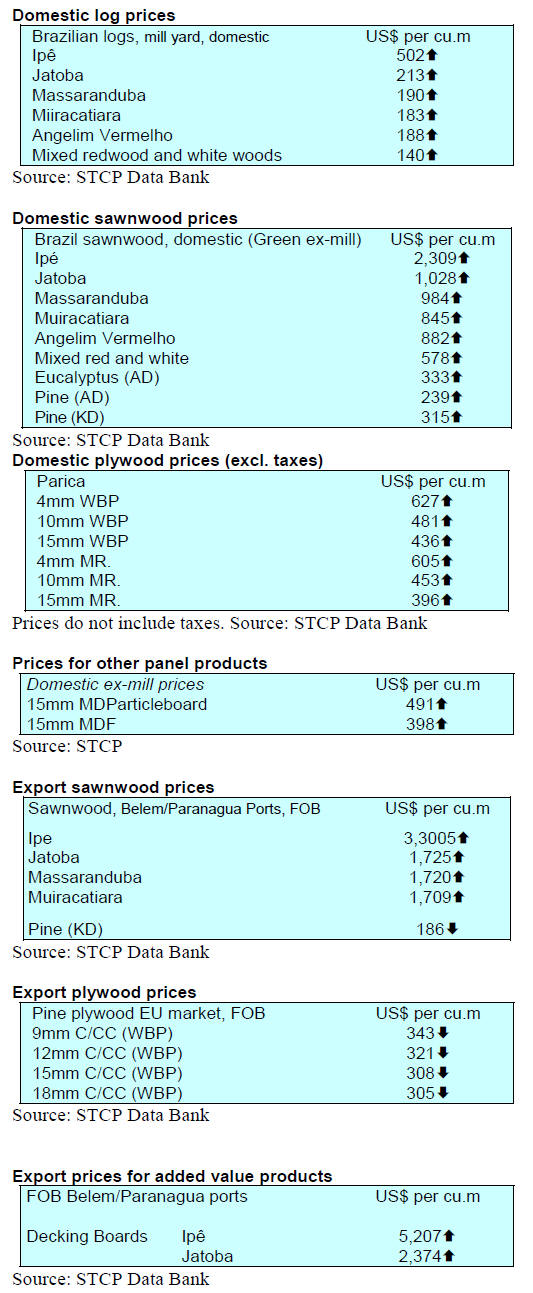
9. PERU
Digital information system for crime
prevention in the
forestry sector
As part of its contribution to information management in
the forestry and wildlife sector the Agency for the
Supervision of Forest Resources and Wildlife (OSINFOR)
has improved its region information system (SIADO) to
allow for the capture of information from regional
authorities.
See:
https://www.gob.pe/institucion/osinfor/noticias/730943-osinfor-optimiza-el-sistema-de-informacion-digital-para-laprevencion-de-delitos-en-el-sector-forestal-y-de-fauna-silvestre
These improvements were possible through technical
support from USAID's Prevenir project. One of the most
significant advances implemented is the improvement of
document transfer in the SIADO Region module which
allows the Regional Forestry and Wildlife Authorities
(ARFFS) to preserve digital information that can be
accessed from anywhere.The use of the SIADO Region
has allowed the Regional Governments of Ucayali, Loreto
and Madre de Dios to rapidly make available management
data.
OSINFOR and the National Forest and Wildlife Service
(SERFOR) have implemented a process so that incoming
information is also available within the framework of the
National Forest and Wildlife Information System.
Algorithm to detect logging in Peru
With the aim of improving the supervision of resources in
the Amazon the OSINFOR announced an algorithm that it
has been using to detect felling in the Peruvian Amazon.
The algorithm was developed and perfected jointly with
the World Resources Institute (WRI) and expert
researchers from the University of Sheffield in order to
timely identify cases of legal and illegal logging and thus
contribute to the traceability of the value chain of the
wood from the source.
The algorithm can identify more subtle disturbances, not
just in areas of massive deforestation.
See:
https://www.gob.pe/institucion/osinfor/noticias/726199-conel-apoyo-de-la-academia-internacional-osinfor-aplica-algoritmopara-deteccion-de-tala-selectiva-en-el-peru
OSINFOR and SERFOR renew commitment to
strengthen the forestry and wildlife sector
OSINFOR and SERFOR have signed addendums to the
Framework Agreement and the Specific Inter-institutional
Cooperation Agreement to reinforce their strategic alliance
to contribute to the strengthening of the forestry and
wildlife sector in Peru.
The renewal of these agreements extends to 2025 the
commitments by both parties in terms of providing
technical and legal support to strengthen their functions,
identifying opportunities for improvement in the forest
regulatory framework, designing strategies for training,
capacity building and exchange of experiences, promotion
of information technologies and information exchange.
